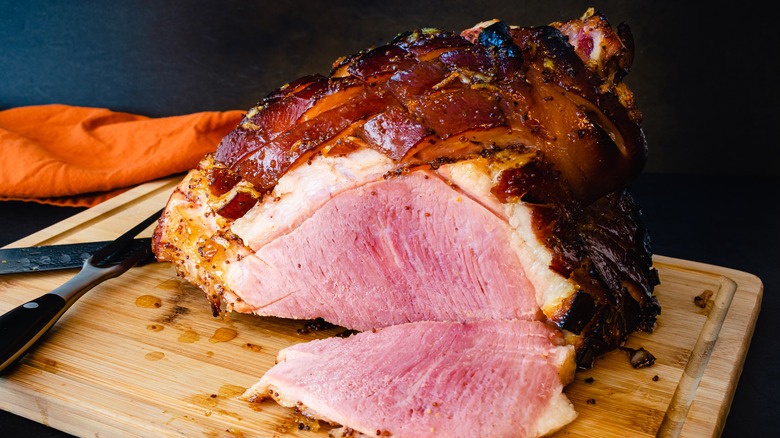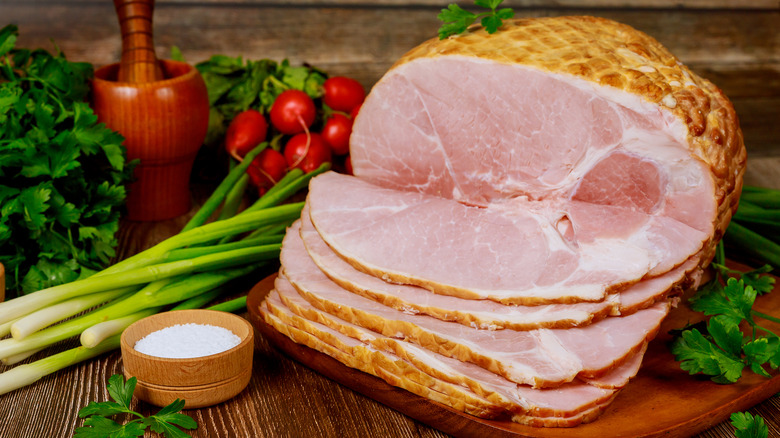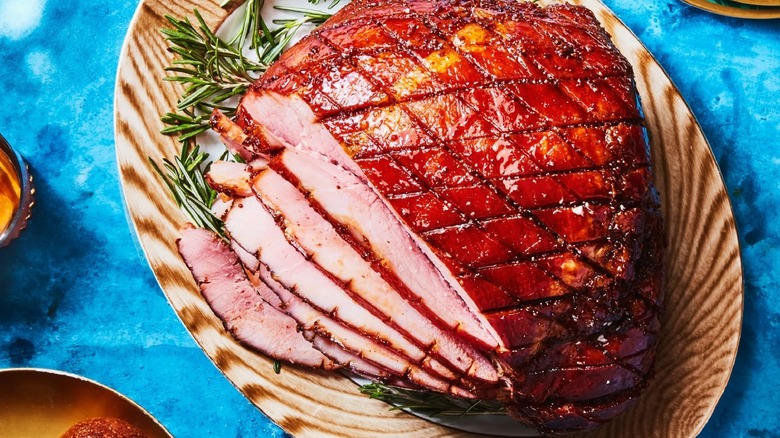The Temperature Sweet Spot You Need For Moist, Crispy Ham
When it comes to feeding a crowd with a centerpiece-worthy entrée, look no further than a nice, juicy ham. Hams are big enough to feed large parties and usually come pre-cooked, which makes them a safer option as well. But it can spell disaster if your ham is overcooked. Price of Meat points out that an overcooked ham loses all of its fat and juices, and leaves you with a tough, dry hunk of meat that won't be impressing anyone.
The City Cook claims that pre-cooked hams are a common option in many groceries and delis throughout the country. Most have been either cured in a wet brine or given a dry rub and air cured in the case of country hams. Most country hams will then be fully smoked as well. This smoking process pre-cooks the meat and helps to kill many of the dangerous bacteria that would otherwise be present in it.
The City Cook adds that not every ham is going to be pre-cooked. This means that it is important to properly read labels, or have a chat with your butcher when picking out your ham for the next dinner party or holiday gathering. Because most hams are pre-cooked, they require a unique approach when it comes time to prepare them for dinner as well.
Hams need a gentler heat
Because many hams are pre-cooked, they don't need an intense heat to prepare them — just enough to reheating them for serving. The U.S. Department of Agriculture points out that uncooked hams will need to reach an internal temperature of at least 160 degrees Fahrenheit before they can be safely consumed. However, pre-cooked hams only need to reach 140, and going past this temperature runs the risk of drying out your ham. Even if you have some water with it in the roasting pan, those higher temperatures will put too much stress on a smoked ham, and leave it tasting dry and tough.
A good way to avoid overcooking your ham is to keep your temperature nice and low. This allows for a more gradual rise in heat, and helps you avoid missing when the ham meets its internal temperature threshold. The best oven setting for most pre-cooked hams is around 300 degrees Fahrenheit. This will perfectly reheat a pre-cooked ham — but it may also create problems for your glaze.
How to perfect the glaze
Most pre-cooked hams are also going to come with a packet of some kind of sweet glaze. This glaze adds tons of flavor to the skin of the ham. It also usually has some sweetness to it to help balance out ham's saltier profile. Southern Living says that scoring the outer skin will help some of that glaze make contact with the ham's interior as well. One of the best parts about the glaze, though, is the crispy, caramelized shell that it creates on the outside of the ham. This stunning crust is one of the best ways to blow guests away as you bring the ham into the dining room.
Getting the glaze just right can be a challenge, though. This is because, as anyone who's ever tried to make caramel can attest, sugars can go from caramelized to burnt in a mere matter of minutes. Setting the oven to 300 degrees Fahrenheit helps avoid burning the glaze for the same reasons it helps avoid overcooking the ham. The problem is that this temperature might not be enough to caramelize the glaze. If that's the case, then feel free to crank the temperature up to 450 just before taking the ham out. Just be careful to keep an eye on it to avoid burning.


